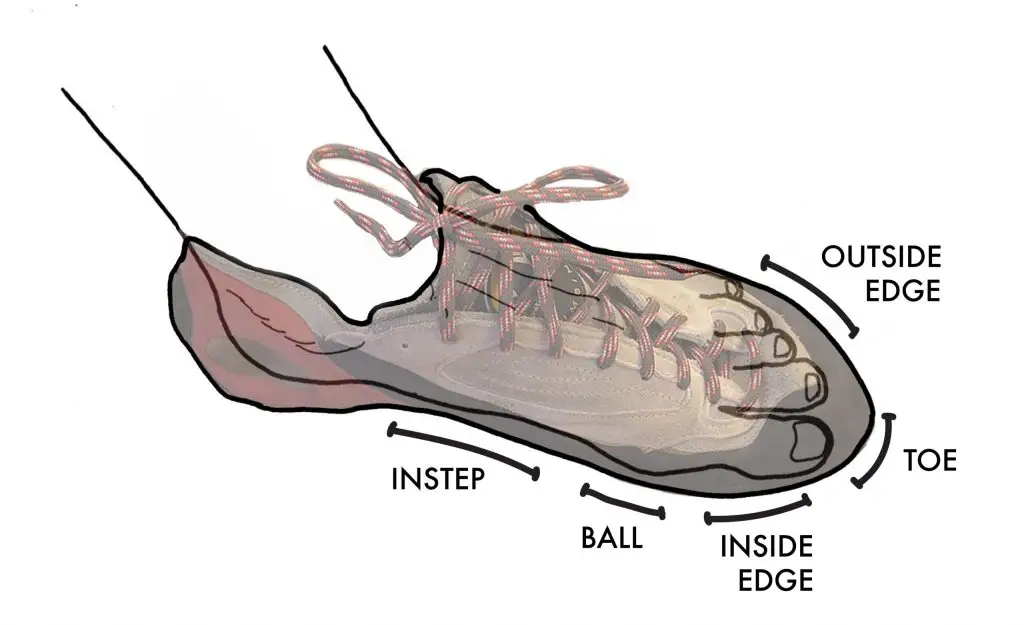New to climbing? You've come to the right place.
Let’s cover the two mistakes newer climbers should avoid with their climbing shoes. Firstly, avoid standing on the ball of the foot or instep. And secondly, avoid standing on the outside edge.
If you aren’t familiar with the balance points of climbing shoes, I’d suggest reading our previous article “Understanding Your Climbing Shoes.” For a quick reference, the balance points are the inside edge, the outside edge, and the toe.
For this article, we will be focused on the inside edge and how it relates to climbing efficiently. Why should newer climbers avoid these mistakes with their climbing shoes? Let’s go into detail below.
Mistake #1 Avoid Standing on the Ball of the Foot or Instep.
When climbers first get started in this sport, they have a tendency to shy away from the true inside edge. They tend to favor the ball of their foot (the bony ridge where the toes all attach to the top of the foot) or their instep whenever possible.
This is a reaction to the feeling that they simply cannot support all of their weight on their “big toe”. This frequently leads to climbers placing the ball of their foot, or even the instep (if a hold is large enough), onto a foothold.
While this may seem a more “reasonable” place to support your full weight, it has several drawbacks. This is a bad habit that will severely stunt your progress.

Can Lead to Bad Habits
Some footholds, particularly on easier routes, are large enough to stand on any way you please. But most are fairly small, and they get smaller as the difficulty increases.
As a result, standing on the ball of the foot or the instep creates a very precarious balance point. It is actually more difficult than people realize to maintain.
This inherent instability can lead new climbers to develop poor habits. An example is an overreliance on their arms. Another example is getting into positions that are difficult to move from.
Easier to Fall Off
If you stand on the ball of your foot, or your instep, and your foot shifts much at all, it is extremely easy to pop off of the foothold. This is especially true if you try to rotate your foot.
Standing on your inside edge provides better options to maintain your balance. It even provides more flexibility to move into new positions.
Trust Your Big Toe
The feeling that your big toe is simply not strong enough to support your weight is quite common. However, it ignores the work that your climbing shoe does to spread the load out over the entire foot.
While it can take getting used to, one of the most important steps in mastering rock climbing is to learn to trust your climbing shoes.
It is your climbing shoes’ job to support your weight. Especially if it’s on only a fraction of the surface area than you might normally think possible. They really are a marvelous invention.
Mistake #2 Refrain from Standing on the Outside Edge
The outside edge of the foot is used primarily for special moves. They are twist-locks, specific positions called back-steps, and drop-knees.
There may be an occasion to use this part of the shoe on lower angled walls (slab and vertical). However, at lower difficulties, this can lead to inefficient habits and is unnecessary.
The primary reason for this is that lower-angle climbing is very much about getting one’s hips as close to the wall as possible. However, outside edge positions can turn one side of your hip into the wall. This will force your center of gravity slightly away from the wall. And in turn, cause more work for your arms, and interfere with good balance.
As climbs get steeper, these positions can be very effective at creating leverage, compensating for the extra work on your arms. Take a look at our article “How to Climb Efficiently” to see why we concentrate on the inside edge of shoes.
Mistakes Newer Climbers Should Avoid
If you’re new to climbing, avoid standing on the ball or instep of your foot. And avoid standing on the outside edge. As your climbing skill progress, there will be times that you will use different parts of your shoe on footholds. But if you are just starting out, keep these tips in mind.
All material is reprinted with the permission of the author. Copyright 2022 David H. Rowland. All rights reserved.




